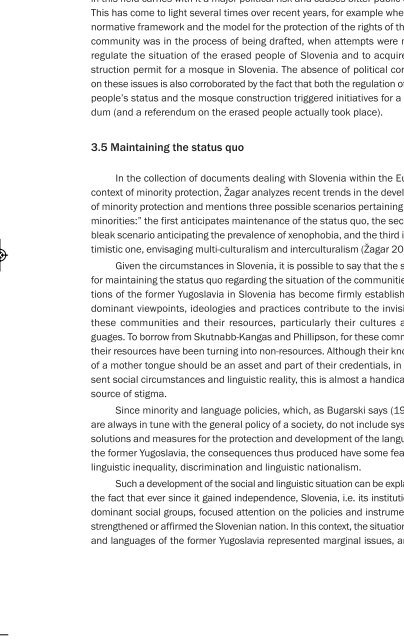The Scars of the Erasure_web
The Scars of the Erasure_web
The Scars of the Erasure_web
- No tags were found...
You also want an ePaper? Increase the reach of your titles
YUMPU automatically turns print PDFs into web optimized ePapers that Google loves.
<strong>Erasure</strong>_4a 10.1.11 20:29 Page 242242 THE SCARS OF THE ERASUREfor any government <strong>of</strong> sovereign Slovenia so far to tackle. <strong>The</strong> present extentand method <strong>of</strong> minority protection (<strong>of</strong> <strong>the</strong> Italian and Hungarian national minorities)in Slovenia rests on <strong>the</strong> basis established by <strong>the</strong> former common state, andit obviously enjoys a broad political and social consensus. However, any changein this field carries with it a major political risk and causes bitter public dispute.This has come to light several times over recent years, for example when a newnormative framework and <strong>the</strong> model for <strong>the</strong> protection <strong>of</strong> <strong>the</strong> rights <strong>of</strong> <strong>the</strong> Romacommunity was in <strong>the</strong> process <strong>of</strong> being drafted, when attempts were made toregulate <strong>the</strong> situation <strong>of</strong> <strong>the</strong> erased people <strong>of</strong> Slovenia and to acquire a constructionpermit for a mosque in Slovenia. <strong>The</strong> absence <strong>of</strong> political consensuson <strong>the</strong>se issues is also corroborated by <strong>the</strong> fact that both <strong>the</strong> regulation <strong>of</strong> erasedpeople’s status and <strong>the</strong> mosque construction triggered initiatives for a referendum(and a referendum on <strong>the</strong> erased people actually took place).3.5 Maintaining <strong>the</strong> status quoIn <strong>the</strong> collection <strong>of</strong> documents dealing with Slovenia within <strong>the</strong> Europeancontext <strong>of</strong> minority protection, Žagar analyzes recent trends in <strong>the</strong> development<strong>of</strong> minority protection and mentions three possible scenarios pertaining to “newminorities:” <strong>the</strong> first anticipates maintenance <strong>of</strong> <strong>the</strong> status quo, <strong>the</strong> second is ableak scenario anticipating <strong>the</strong> prevalence <strong>of</strong> xenophobia, and <strong>the</strong> third is an optimisticone, envisaging multi-culturalism and interculturalism (Žagar 2002, 81).Given <strong>the</strong> circumstances in Slovenia, it is possible to say that <strong>the</strong> scenari<strong>of</strong>or maintaining <strong>the</strong> status quo regarding <strong>the</strong> situation <strong>of</strong> <strong>the</strong> communities <strong>of</strong> nations<strong>of</strong> <strong>the</strong> former Yugoslavia in Slovenia has become firmly established. <strong>The</strong>dominant viewpoints, ideologies and practices contribute to <strong>the</strong> invisibility <strong>of</strong><strong>the</strong>se communities and <strong>the</strong>ir resources, particularly <strong>the</strong>ir cultures and languages.To borrow from Skutnabb-Kangas and Phillipson, for <strong>the</strong>se communities<strong>the</strong>ir resources have been turning into non-resources. Although <strong>the</strong>ir knowledge<strong>of</strong> a mo<strong>the</strong>r tongue should be an asset and part <strong>of</strong> <strong>the</strong>ir credentials, in <strong>the</strong> pre -sent social circumstances and linguistic reality, this is almost a handicap and asource <strong>of</strong> stigma.Since minority and language policies, which, as Bugarski says (1997, 20)are always in tune with <strong>the</strong> general policy <strong>of</strong> a society, do not include systematicsolutions and measures for <strong>the</strong> protection and development <strong>of</strong> <strong>the</strong> languages <strong>of</strong><strong>the</strong> former Yugoslavia, <strong>the</strong> consequences thus produced have some features <strong>of</strong>linguistic inequality, discrimination and linguistic nationalism.Such a development <strong>of</strong> <strong>the</strong> social and linguistic situation can be explained by<strong>the</strong> fact that ever since it gained independence, Slovenia, i.e. its institutions anddominant social groups, focused attention on <strong>the</strong> policies and instruments thatstreng<strong>the</strong>ned or affirmed <strong>the</strong> Slovenian nation. In this context, <strong>the</strong> situation, statusand languages <strong>of</strong> <strong>the</strong> former Yugoslavia represented marginal issues, and ones


